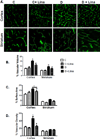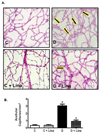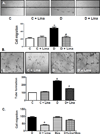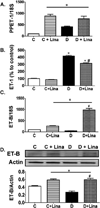Linagliptin attenuates diabetes-induced cerebral pathological neovascularization in a blood glucose-independent manner: Potential role of ET-1
- PMID: 26631506
- PMCID: PMC4882278
- DOI: 10.1016/j.lfs.2015.11.026
Linagliptin attenuates diabetes-induced cerebral pathological neovascularization in a blood glucose-independent manner: Potential role of ET-1
Abstract
Aims: We have shown that glycemic control with metformin or endothelin-1 (ET-1) inhibition with bosentan prevents and restores diabetes-mediated cerebral pathological remodeling and neovascularization. Our recent data suggest that linagliptin, a member of the dipeptidyl peptidase-4 inhibitor class of glucose-lowering agents, prevents cerebrovascular remodeling and dysfunction independent of its blood glucose lowering effects. We hypothesized that linagliptin prevents pathological neovascularization via the modulation of the ET-1 system.
Materials and methods: 24-week old diabetic Goto-Kakizaki and nondiabetic Wistar rats were treated for 4weeks with either vehicle chow or chow containing 166mg/kg linagliptin. At termination, FITC-dextran was injected to visualize the vasculature. Brain sections were imaged by confocal microscopy for vascular density, tortuosity, vascular volume, and surface in both the cortex and striatum. Retinal acellular capillary formation was measured. Brain microvascular endothelial cells (BMVEC) isolated from control or diabetic rats were treated with linagliptin with or without ET-1 dual receptor antagonist and tested for angiogenic properties with cell migration and tube formation assays.
Key finding: Linagliptin reduced all indices of cerebral neovascularization compared with control rats. In vitro, linagliptin normalized the augmented angiogenic properties of BMVECs isolated from diabetic animals and bosentan reversed this response. Cells from diabetic animals had higher ET-1 and less ETB receptors than in control cells. Linagliptin significantly decreased ET-1 levels and increased ETB receptors.
Significance: ET system contributes to pathological neovascularization in diabetes as evidenced by restoration of functional angiogenesis by bosentan treatment and prevention of linagliptin-mediated improvement of angiogenesis in the in vitro model.
Keywords: Diabetes; Endothelin; Linagliptin and neovascularization.
Copyright © 2015 Elsevier Inc. All rights reserved.
Conflict of interest statement
statement Authors declare no conflict of interest.
Figures





References
-
- American Diabetes Association. National diabetes fact sheet. 2015 http://www.diabetes.org/diabetes-statistics.jsp.
MeSH terms
Substances
Grants and funding
LinkOut - more resources
Full Text Sources
Other Literature Sources
Medical

